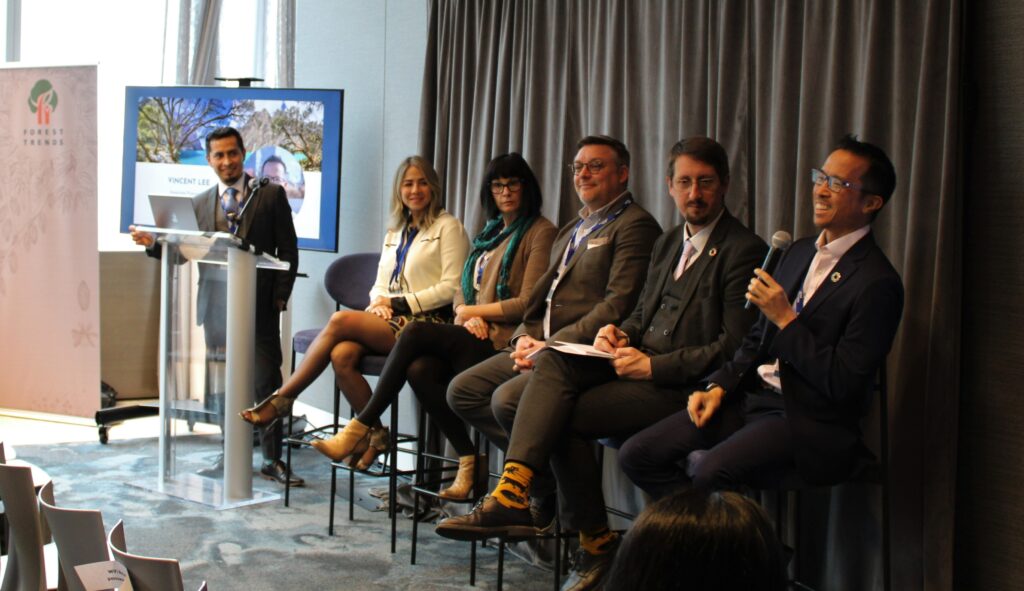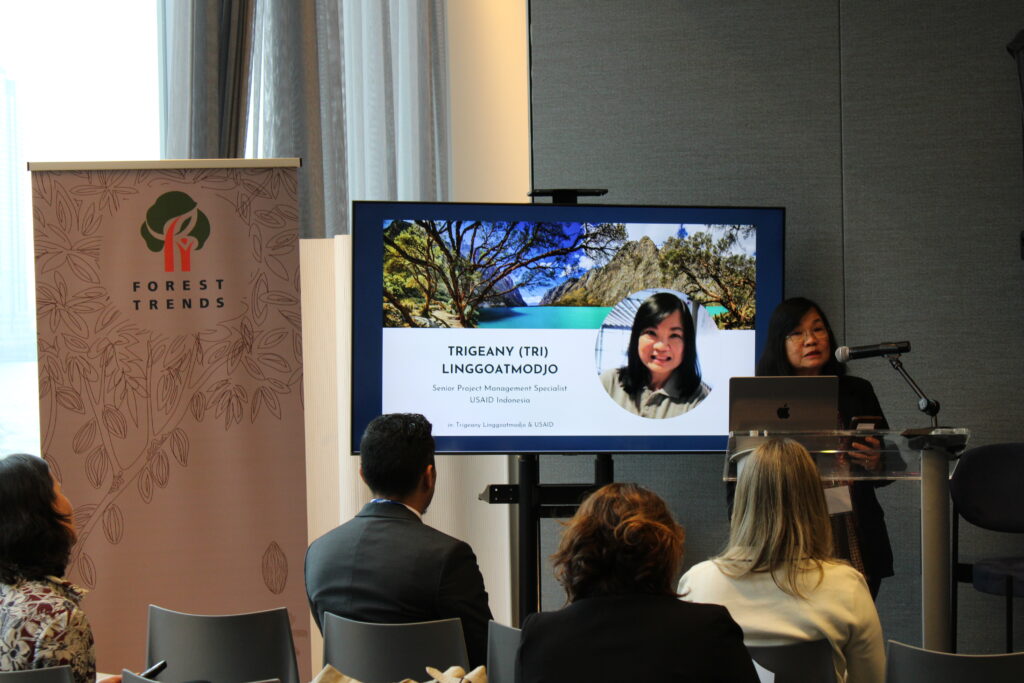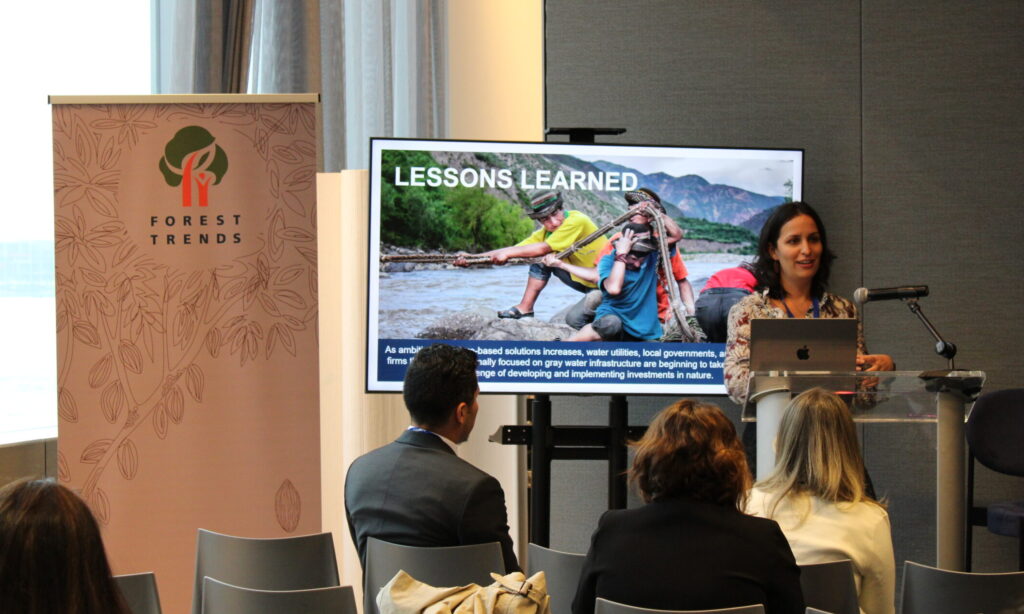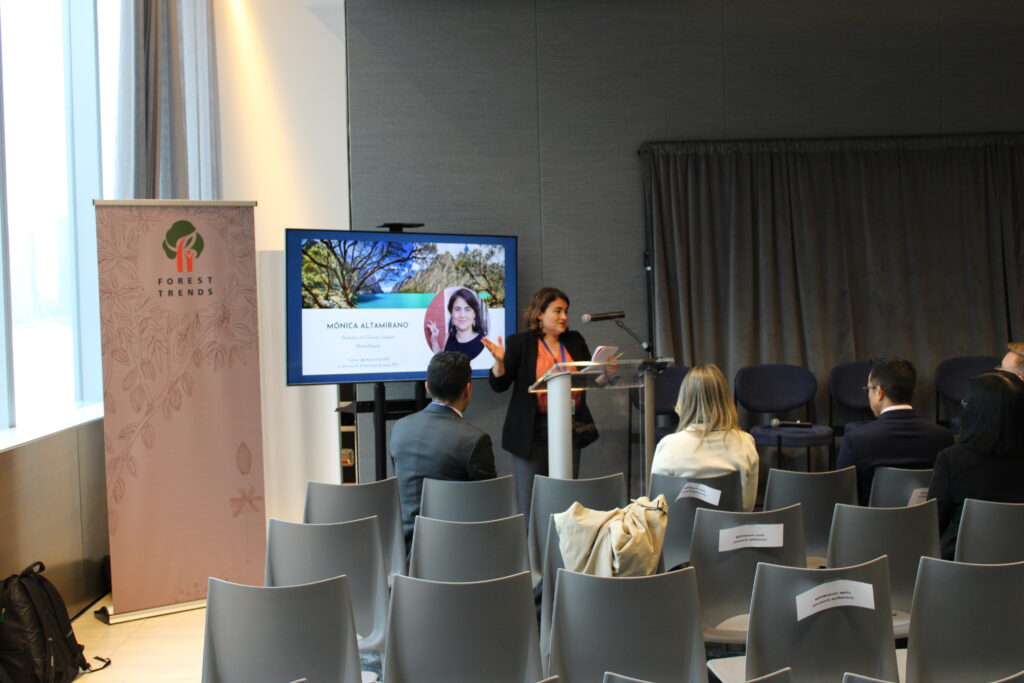Last week we were honored to gather experts and practitioners at the Nature Hub in New York City during the UN Water Conference – the first in 46 years – to share lessons learned on scaling up nature-based solutions (NBS) for water. The main aim of the conference this year was to accelerate action to achieve Sustainable Development Goal (SDG) 6: Ensure access to clean water and sanitation for all by 2030. The Nature Hub, located a short walk from UN Headquarters, aimed to ensure that nature was considered as part of the UN’s agenda and to gather practitioners of NBS to share their experiences (co-hosted by Forest Trends, The Nature Conservancy, WWF, IUCN, World Water Council, International Water Management Institute, International Network of Basin Organizers). As co-hosts and organizers of two events, we were proud to help elevate NBS on a global stage.
While there are many successful cases of NBS, experience is limited when it comes to bringing these solutions to scale, which we will need to meet global climate goals. Matching the scale of NBS’ potential to support water security with action on the ground will require a new set of strategies on policy, finance, and implementation. Fortunately, early adopters are starting to generate valuable lessons for scaling up NBS for water security. Peru has made particularly remarkable progress, with a 12x increase in NBS investments implemented over the last decade.

Our experience supporting watershed investments includes work in Bolivia, Brazil, Peru, Mexico, Ghana, China, and the US. Our work to mainstream and scale NBS since 2017 has primarily been focused on Peru through the Natural Infrastructure for Water Security (NIWS) project, supported by USAID and the Government of Canada. Together with our partners, we have been working to scale-up gender-sensitive investments in natural infrastructure in Peru as a strategy to regulate water supply and increase resilience to climate change. There is now more than a quarter billion dollars committed to new investment in NBS for water in Peru, secured with our support. (Sign up here to receive updates on our upcoming report series: Lessons Learned in Scaling Natural Infrastructure in Peru).
Likewise, experiences bringing NBS to a national scale in France, addressing systemic wildfire risk to watersheds in the western US, cross-sector efforts to conserve the watersheds of large cities, like Santo Domingo, Dominican Republic, and installing urban green infrastructure in New York City, have begun to yield important lessons on the key elements and challenges for building the scaffolding needed for scale.
Our speakers last week shared their most important takeaways from those experiences, which we have combined here with our own from Peru:
1) We need to leverage rising global ambition on NBS to keep driving the funding and systemic change that will enable adoption across sectors.
Tri Linggoatmodjo, Senior Project Management Specialist at USAID Indonesia, emphasized the importance of the opportunity presented by rising global ambition on NBS for water security. She said that they

have discovered the value of NBS to improving WASH (Water, Sanitation, and Hygiene) efforts in Indonesia and sustainable land management upstream for safer, cleaner water downstream. At the same time, she has observed the evolution of the US Government’s strategies to directly support NBS as critical to water security and climate resilience (e.g., US Government Global Water Strategy and USAID’s Climate Change Strategy). And this is only one country – 142 countries include NBS in their nationally determined contributions (NDCs), and 124 of them specifically mention increased water security as a key outcome. At least four more additional countries announced new action items related to NBS during the UN Water Conference.
These examples all show that NBS are poised to scale. However, reaching the scale needed to support water security will require us to work differently than we have in the past – we need to look to new strategies on policy, planning, finance, capacity-building, and implementation.
2) We need to clarify how we are defining NBS before we make commitments and execute projects.
As we work to scale NBS, many institutions that have historically focused on gray infrastructure, such as utilities, governments, and landowners, are just getting to know the concept.
As Cyrille Bárnerias, Director of International Relations for France’s Biodiversity Agency (OFB), pointed out, it can be surprising how different our definitions of NBS are across sectors and institutions. It’s worth taking time to clearly define terms and hear each other’s understandings. More of their reflections here.
3) Our systems are not incentivized to report on or learn from failure, leaving much to individual champions of NBS to navigate systems that were not designed with adaptation in mind.
Doing anything for the first time requires intention and humility to navigate the unknown and learn from what inevitably doesn’t go as planned. As Seth Schultz of Resilience Rising pointed out, some key actors in scaling NBS, such as engineers and city planners, have little incentive to change the way they have been operating for decades – it’s hard to be the first one to stick your neck out, make a change, and incur the potential risk of doing so.
That said, Gena Gammie, Director of Forest Trends’ Water Initiative, reinforced that NBS are not necessarily more risky than grey infrastructure, but incorporating NBS does require our practitioners and institutions to learn to think differently about risk. And to confront the risk of not changing how we design infrastructure for water – our engineered solutions of the 20th century are aging and already consistently failing to meet the needs of people and landscapes, and this does not even account for the continued uncertainties in weather and water supply widely expected by climate change. She further notes that in Peru, they came to embrace an unavoidable element of “learning by doing” that has ultimately served them well on their journey to mainstreaming NBS.
Vincent Lee, Associate Principal and Technical Director of Water from engineering firm ARUP, recounted his experience implementing NBS in New York City; they were directed to four different city departments as they tried to acquire proper permits and permissions – no one felt they were responsible for or “owned” NBS or didn’t want to. While they ultimately succeeded in installing roadside bioswales across over 1,300 acres in the city, the process opened his eyes to the need to use their experience to help create a more streamlined process for future practitioners and decision makers. And a sense of ownership and excitement about the potential of NBS.
4) The systems change we need to mainstream NBS requires peer-to-peer learning experiences and exposure to what success can look like.
Mónica Altamirano, Director of Climate Impact at WaterEquity, noted that NBS are starting to face challenges similar to those experienced by the broader water sector, and that we can and should learn from each other.
Some of the discomfort of “learning by doing” can be relieved by peer-to-peer exchanges. Talking to someone who has been through an unfamiliar process helps newcomers feel that they can navigate it, too. Officials in Lima, Peru learned about NBS implementation from counterparts in Quito, Ecuador and visited project sites. Practitioners in New York City learned from case studies in Portland and Seattle in Washington state.

5) Institutions need to develop processes for NBS with clear guidelines and technical specifications and build capacity for using them across sectors.
Gena, Seth, and Vincent all emphasized that we will also need standards and codes to guide practitioners and decision makers as they shepherd NBS through design, procurement, and implementation. Doing so ensures institutions are capturing what they are learning and laying the foundation for quality control and effective implementation over the long term.
One powerful example from the NIWS project in Peru was a manual for water utilities to formulate and evaluate public investments in natural infrastructure that, when used, reduced the time from idea to agreement by 80%. Other guidelines and tools compiled the best available science accessibly to ensure it was actionable for practitioners and decision makers.
The NIWS project also applied management and technical trainings with NBS funders and contractors to connect professionals across disciplines, building the market and a learning community. Graduates of the programs increased project design skills and learned how to incorporate natural infrastructure into public planning, budgeting, and prioritization processes.
6) Funders and standards need to remain flexible enough to allow NBS to be responsive to local needs.
Rebecca Davidson, Senior Director of Conservation Programs at the National Forest Foundation, highlighted how critical it is in their work in the western US to have the flexibility to treat each NBS as completely unique: “No square foot of a watershed is the same, just as no community is the same, so our projects need to reflect that.”
Patricia Abreu Fernández, Executive Director of the Santo Domingo Water Fund in the Dominican Republic, echoed that message in her stories of working with landowners on the island and needing to turn on a dime to not only educate them on NBS, but design custom solutions, all while keeping the big picture of national water security in mind. What’s more, landowners who became NBS advocates helped spread interest across their community through word of mouth and demonstrated improvements to their livelihoods.
7) We must adapt our systems to reduce barriers to participation and increase benefits to local communities.
As primary stewards of our landscapes, local communities are key partners to any NBS. They hold traditional knowledge that is critical to successful design, implementation, monitoring, and long-term maintenance of NBS investments. They need to be engaged as equal partners from day one. However, many NBS planning and implementation processes are not accessible to local communities.
Gena pointed out that in some cases in Peru, NBS takes the form of restoring traditional water management practices, like amunas (pre-Incan infiltration canals), which not only help store and release water during times of shortage at regional levels but increase local benefits and revalues local knowledge. However, current public investment structures in Peru are not set up to work directly with local communities on NBS. Public procurement policy required communities to enter a lengthy competitive bid process and provide project insurance – a massive barrier for most small communities, even if they wanted to participate. Addressing this will require a transformation in sectors that are designed to build dams, for example, not consider communities as equal partners or restore their traditional infrastructure.
Preparing to make big changes
A key lesson from Peru was to recognize the limitations of existing implementation mechanisms. Doing so helped set expectations about those limitations and move forward with clearer alignment and

understanding of goals and what NBS could and could not achieve in a given context. It also opened the door to creativity – where appropriate, they explored and developed alternatives that could be more agile, equitable, and sustainable than public investment systems.
In her closing remarks, Mónica reminded the audience that all these shifts we need to make in our existing systems to enable NBS may not always be possible, and we may need to design new ones: “if that feels like trying to ‘fit a square peg in a round hole,’ we may need to rethink how to fundamentally shift our model of development toward more empowered participation.” We’ll need these kinds of fundamental shifts to scale-up and sustain not only NBS, but the range of solutions and partnerships needed to hit our SDG 6 targets and build resilience in the face of a changing climate.
Viewpoints showcases expert analysis and commentary from the Forest Trends team.
Connect with us on Facebook and Twitter to follow our latest work.
